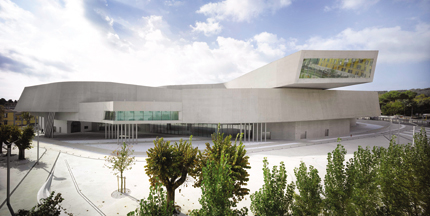
The MAXXI, the new Museum of 21st Century Art, recently inaugurated in Rome, is Zaha Hadid’s first built work in Italy. It was thus long awaited, above all by its critics. In reality, Hadid has numerous other projects under construction in Italy, all controversial and the source of infinite contestations.
The MAXXI, in particular, was subject to the following criticisms: a) the work was impossible to build; b) even if it could be built, it would have cost much more than anything designed by Italian architects; c) it could never fit into the historical context of the city of Rome; d) the building would be a jumble of unusable space; and e) the running and management costs would be exorbitant.
The first criticism—that the building was perhaps impossible to build—was obviously disproven by its inauguration, though it must be said that the reinforced concrete structure is literally packed with steel, in order to ensure that it complies with Italian building regulations. This led to a few difficulties, though no particular delays. That fact that the construction site lasted for almost ten years is due to problems not directly imputable to the architect but, above all, to the slow distribution of the financing for its construction.
Regarding the second criticism, it must be said that the final cost of the project was 150 million euros (approximately $220 million) for a total of 215,000 square feet), or $1,150 per square foot. An excessive number if we consider that the cost of building Frank Gehry’s Guggenheim Museum in Bilbao was only 100 million euros, franchising license included. In Hadid’s favor, it must be said that the Guggenheim was inaugurated in 1997, and thus we must consider a reduction in buying power during this 12-year gap. What is more, public works in Italy, regardless of their architect, have always cost more than those constructed elsewhere. The Italian television program Report, which denounces waste and inefficiency in the country, has demonstrated, for example, that the cost of constructing rail lines or highways paid by the Italian state is double or even triple that paid by the French or the Spanish.
Roland Halbe
The third criticism is contestable, given that we each have our own parameters for judging the correct or incorrect insertion of a work within the urban context. Setting aside its strongest detractors, however, including professor Paolo Portoghesi, the building has been warmly welcomed.
In reality, it is difficult to speak poorly of the new museum: the interior, above all, is impressive for the dynamic quality of its spaces and is extremely fascinating, even to those with a lukewarm attitude toward contemporary architecture.
Furthermore, to facilitate the museum’s insertion within its context, Hadid agreed to keep the remains of a piece of the pre-existing military barracks. This move has proven strategic, as it demonstrates that even this Iraqi architect holds a place in her heart for a relationship with the history of the city. In formal terms it is, in my opinion, a grave error. The conserved barracks building disturbs the design of the project and impedes the strong and decisive presence of the new structure along the Via Guido Reni. What is more, for structural reasons this element was demolished and reconstructed “where and as it was,” and thus appears more akin to something from Disneyland.
A second design error can be found in project’s new fence. By defining the lot on which the building sits, it compromises the dynamic of the flows—the continuum—that was to have existed between the streets around the museum, the garden in front of it, and the entry hall.
To test the validity of the second-last criticism, relative to its functionality, we will have to await the spring of 2010 and the opening of the first exhibitions. In fact, with great cunning, the December inauguration was only for the building, which is currently empty. Why? Simple: to pretend that the project was finished in 2009 and not 2010, and to generate attention. What is more, the spring of 2010 will thus be witness to another inauguration and more publicity. Demagogy or a waste of resources? Maybe both. However, this is typical in Rome. Both Richard Meier’s Ara Pacis Museum and Renzo Piano’s Auditorium were inaugurated twice.
Helene Binet
What is certain is that the museum’s design as a continuous sequence of paths means it will not be easy to design exhibitions. Truth be told, it will be extremely difficult. However, I could not help but respond that all of the most interesting museums built over the last 50 years are difficult to work with, from the Guggenheim in New York to Bilbao. And if artists prefer white boxes, it is a good thing that institutions do not turn to talented architects but, as we have seen at MoMA, choose others with less talent and a more calming approach.
The problem, however, is that the MAXXI’s exhibition program, at least as it has been announced, appears nothing short of depressing. We need only mention that the first architectural exhibition will focus on the work of Luigi Moretti, the architect of Benito Mussolini’s Gymnasium at the Foro Italico in Rome. In short: a protagonist of the 20th, and not the 21st, century.
Finally, the costs of maintenance. Just how much will it cost? There is no way to develop a precise figure. However, if anything can be made of a few offhand comments from Pio Baldi, the director of the foundation that manages the structure, they will be nothing short of exorbitant. The building pays the price of having been designed over ten years ago. Today, most likely, it would have adopted more sustainable and thus more energy-efficient solutions.
One could respond by saying that these issues were on the agenda back in 1998, when the competition was held for the MAXXI. This is true, they were. However, at the time no one paid any attention, at least not in Italy.